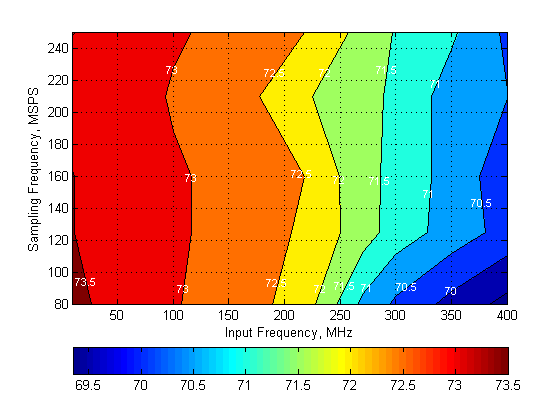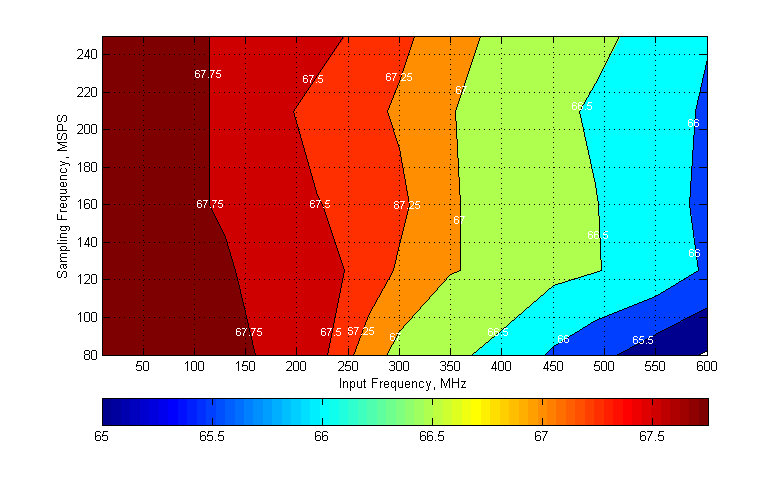SLAS904F October 2012 – May 2016 ADS42LB49 , ADS42LB69
PRODUCTION DATA.
- 1 Features
- 2 Applications
- 3 Description
- 4 Revision History
- 5 Pin Configuration and Functions
-
6 Specifications
- 6.1 Absolute Maximum Ratings
- 6.2 ESD Ratings
- 6.3 Recommended Operating Conditions
- 6.4 Thermal Information
- 6.5 Electrical Characteristics: ADS42LB69 (16-Bit)
- 6.6 Electrical Characteristics: ADS42LB49 (14-Bit)
- 6.7 Electrical Characteristics: General
- 6.8 Digital Characteristics
- 6.9 Timing Requirements: General
- 6.10 Timing Requirements: DDR LVDS Mode
- 6.11 Timing Requirements: QDR LVDS Mode
- 6.12 Typical Characteristics: ADS42LB69
- 6.13 Typical Characteristics: ADS42LB49
- 6.14 Typical Characteristics: Common
- 6.15 Typical Characteristics: Contour
- 7 Parameter Measurement Information
-
8 Detailed Description
- 8.1 Overview
- 8.2 Functional Block Diagrams
- 8.3 Feature Description
- 8.4 Device Functional Modes
- 8.5 Programming
- 8.6
Register Maps
- 8.6.1
Description of Serial Interface Registers
- 8.6.1.1 Register 6 (offset = 06h) [reset = 80h]
- 8.6.1.2 Register 7 (offset = 07h) [reset = 00h]
- 8.6.1.3 Register 8 (offset = 08h) [reset = 00h]
- 8.6.1.4 Register B (offset = 0Bh) [reset = 00h]
- 8.6.1.5 Register C (offset = 0Ch) [reset = 00h]
- 8.6.1.6 Register D (offset = 0Dh) [reset = 6Ch]
- 8.6.1.7 Register F (offset = 0Fh) [reset = 00h]
- 8.6.1.8 Register 10 (offset = 10h) [reset = 00h]
- 8.6.1.9 Register 11 (offset = 11h) [reset = 00h]
- 8.6.1.10 Register 12 (offset = 12h) [reset = 00h]
- 8.6.1.11 Register 13 (offset = 13h) [reset = 00h]
- 8.6.1.12 Register 14 (offset = 14h) [reset = 00h]
- 8.6.1.13 Register 15 (offset = 15h) [reset = 00h]
- 8.6.1.14 Register 16 (offset = 16h) [reset = 00h]
- 8.6.1.15 Register 17 (offset = 17h) [reset = 00h]
- 8.6.1.16 Register 18 (offset = 18h) [reset = 00h]
- 8.6.1.17 Register 1F (offset = 1Fh) [reset = 7Fh]
- 8.6.1.18 Register 20 (offset = 20h) [reset = 00h]
- 8.6.1
Description of Serial Interface Registers
- 9 Application and Implementation
- 10Power Supply Recommendations
- 11Layout
- 12Device and Documentation Support
- 13Mechanical, Packaging, and Orderable Information
Package Options
Mechanical Data (Package|Pins)
- RGC|64
Thermal pad, mechanical data (Package|Pins)
- RGC|64
Orderable Information
6 Specifications
6.1 Absolute Maximum Ratings
over operating free-air temperature range (unless otherwise noted)(1)(1) Stresses beyond those listed under Absolute Maximum Ratings may cause permanent damage to the device. These are stress ratings only, which do not imply functional operation of the device at these or any other conditions beyond those indicated under Recommended Operating Conditions. Exposure to absolute-maximum-rated conditions for extended periods may affect device reliability.
6.2 ESD Ratings
| VALUE | UNIT | |||
|---|---|---|---|---|
| V(ESD) | Electrostatic discharge | Human body model (HBM), per ANSI/ESDA/JEDEC JS-001(1) | ±2000 | V |
(1) JEDEC document JEP155 states that 500-V HBM allows safe manufacturing with a standard ESD control process.
6.3 Recommended Operating Conditions
over operating free-air temperature range (unless otherwise noted)(3)| MIN | NOM | MAX | UNIT | |||
|---|---|---|---|---|---|---|
| SUPPLIES | ||||||
| AVDD | Analog supply voltage | 1.7 | 1.8 | 1.9 | V | |
| AVDD3V | Analog buffer supply voltage | 3.15 | 3.3 | 3.45 | V | |
| DRVDD | Digital supply voltage | 1.7 | 1.8 | 1.9 | V | |
| ANALOG INPUTS | ||||||
| VID | Differential input voltage range | Default after reset | 2 | VPP | ||
| Register programmable(1) | 2.5 | |||||
| VICR | Input common-mode voltage | VCM ± 0.025 | V | |||
| Maximum analog input frequency with 2.5-VPP input amplitude | 250 | MHz | ||||
| Maximum analog input frequency with 2-VPP input amplitude | 400 | MHz | ||||
| CLOCK INPUT | ||||||
| Input clock sample rate | QDR interface | 30 | 250 | MSPS | ||
| DDR interface | 10 | 250 | ||||
| Input clock amplitude differential (VCLKP – VCLKM) |
Sine wave, ac-coupled | 0.3(2) | 1.5 | VPP | ||
| LVPECL, ac-coupled | 1.6 | |||||
| LVDS, ac-coupled | 0.7 | |||||
| LVCMOS, single-ended, ac-coupled | 1.5 | V | ||||
| Input clock duty cycle | 35% | 50% | 65% | |||
| DIGITAL OUTPUTS | ||||||
| CLOAD | Maximum external load capacitance from each output pin to DRGND | 3.3 | pF | |||
| RLOAD | Single-ended load resistance | +50 | Ω | |||
| TA | Operating free-air temperature | –40 | +85 | °C | ||
(1) For details, refer to the Digital Gain section.
(3) After power-up, to reset the device for the first time, only use the RESET pin. Refer to the Register Initialization section.
6.4 Thermal Information
| THERMAL METRIC(1) | ADS42LBx9 | UNIT | |
|---|---|---|---|
| RGC (VQFN) | |||
| 64 PINS | |||
| RθJA | Junction-to-ambient thermal resistance | 22.9 | °C/W |
| RθJC(top) | Junction-to-case (top) thermal resistance | 7.1 | °C/W |
| RθJB | Junction-to-board thermal resistance | 2.5 | °C/W |
| ψJT | Junction-to-top characterization parameter | 0.1 | °C/W |
| ψJB | Junction-to-board characterization parameter | 2.5 | °C/W |
| RθJC(bot) | Junction-to-case (bottom) thermal resistance | 0.2 | °C/W |
(1) For more information about traditional and new thermal metrics, see the IC Package Thermal Metrics application report, SPRA953.
6.5 Electrical Characteristics: ADS42LB69 (16-Bit)
Typical values are at TA = +25°C, AVDD = 1.8 V, AVDD3V = 3.3 V, DRVDD = 1.8 V, 50% clock duty cycle, –1-dBFS differential analog input, and sampling rate = 250 MSPS, unless otherwise noted. Minimum and maximum values are across the full temperature range of TMIN = –40°C to TMAX = +85°C, AVDD = 1.8 V, AVDD3V = 3.3 V, DRVDD = 1.8 V.6.6 Electrical Characteristics: ADS42LB49 (14-Bit)
Typical values are at TA = +25°C, AVDD = 1.8 V, AVDD3V = 3.3 V, DRVDD = 1.8 V, 50% clock duty cycle, –1-dBFS differential analog input, and sampling rate = 250 MSPS, unless otherwise noted. Minimum and maximum values are across the full temperature range of TMIN = –40°C to TMAX = +85°C, AVDD = 1.8 V, AVDD3V = 3.3 V, DRVDD = 1.8 V.6.7 Electrical Characteristics: General
Typical values are at +25°C, AVDD = 1.8 V, AVDD3V = 3.3 V, DRVDD = 1.8 V, 50% clock duty cycle, –1-dBFS differential analog input, and sampling rate = 250 MSPS, unless otherwise noted. Minimum and maximum values are across the full temperature range: TMIN = –40°C to TMAX = +85°C, AVDD = 1.8 V, AVDD3V = 3.3 V, DRVDD = 1.8 V.| PARAMETER | TEST CONDITIONS | MIN | TYP | MAX | UNIT | |
|---|---|---|---|---|---|---|
| ANALOG INPUTS | ||||||
| VID | Differential input voltage range | Default (after reset) | 2 | VPP | ||
| Register programmed(1) | 2.5 | |||||
| Differential input resistance (at 170 MHz) | 1.2 | kΩ | ||||
| Differential input capacitance (at 170 MHz) | 4 | pF | ||||
| Analog input bandwidth | With 50-Ω source impedance, and 50-Ω termination | 900 | MHz | |||
| VCM | Common-mode output voltage | 1.9 | V | |||
| VCM output current capability | 10 | mA | ||||
| DC ACCURACY | ||||||
| Offset error | –20 | 20 | mV | |||
| EGREF | Gain error as a result of internal reference inaccuracy alone | ±2 | %FS | |||
| EGCHAN | Gain error of channel alone | –5 | %FS | |||
| Temperature coefficient of EGCHAN | 0.01 | Δ%/°C | ||||
| POWER SUPPLY | ||||||
| IAVDD | Analog supply current | 141 | 182 | mA | ||
| IAVDD3V | Analog buffer supply current | 302 | 340 | mA | ||
| IDRVDD | Digital and output buffer supply current | External 100-Ω differential termination on LVDS outputs | 219 | 245 | mA | |
| Analog power | 253 | mW | ||||
| Analog buffer power | 996 | mW | ||||
| Power consumption (includes digital blocks and output buffers) | External 100-Ω differential termination on LVDS outputs | 393 | mW | |||
| Total power | 1.64 | 1.85 | W | |||
| Global power-down (both channels) | 160 | mW | ||||
(1) Refer to the Serial Interface section.
6.8 Digital Characteristics
The dc specifications refer to the condition where the digital outputs are not switching, but are permanently at a valid logic level '0' or '1'. AVDD = 1.8 V, AVDD3V = 3.3 V, DRVDD = 1.8 V, and, unless otherwise noted.| PARAMETER | TEST CONDITIONS | MIN | TYP | MAX | UNIT | ||
|---|---|---|---|---|---|---|---|
| DIGITAL INPUTS (RESET, SCLK, SDATA, SEN, CTRL1, CTRL2)(1) | |||||||
| VIH | High-level input voltage | All digital inputs support 1.8-V and 3.3-V CMOS logic levels | 1.3 | V | |||
| VIL | Low-level input voltage | 0.4 | V | ||||
| IIH | High-level input current | RESET, SDATA, SCLK, CTRL1, CTRL2(2) | VHIGH = 1.8 V | 10 | µA | ||
| SEN(3) | VHIGH = 1.8 V | 0 | |||||
| IIL | Low-level input current | RESET, SDATA, SCLK, CTRL1, CTRL2 | VLOW = 0 V | 0 | µA | ||
| SEN | VLOW = 0 V | 10 | |||||
| DIGITAL OUTPUTS, CMOS INTERFACE (OVRA, OVRB, SDOUT) | |||||||
| VOH | High-level output voltage | DRVDD – 0.1 | DRVDD | V | |||
| VOL | Low-level output voltage | 0 | 0.1 | V | |||
| DIGITAL OUTPUTS, LVDS INTERFACE | |||||||
| VODH | High-level output differential voltage | With an external 100-Ω termination |
250 | 350 | 500 | mV | |
| VODL | Low-level output differential voltage | With an external 100-Ω termination |
–500 | –350 | –250 | mV | |
| VOCM | Output common-mode voltage | 1.05 | V | ||||
(1) SCLK, SDATA, and SEN function as digital input pins in serial configuration mode.
(2) SDATA and SCLK have an internal 150-kΩ pull-down resistor.
(3) SEN has an internal 150-kΩ pull-up resistor to AVDD. Because the pull-up resistor is weak, SEN can also be driven by 1.8-V or 3.3-V CMOS buffers.
6.9 Timing Requirements: General
Typical values are at +25°C, AVDD = 1.8 V, AVDD3V = 3.3 V, DRVDD = 1.8 V, sampling frequency = 250 MSPS, sine wave input clock, CLOAD = 3.3 pF, and RLOAD = 100 Ω, unless otherwise noted. Minimum and maximum values are across the full temperature range: TMIN = –40°C to TMAX = +85°C, AVDD = 1.8 V, AVDD3V = 3.3 V, DRVDD = 1.7 V to 1.9 V.| MIN | TYP | MAX | UNIT | |||
|---|---|---|---|---|---|---|
| tA | Aperture delay | 0.5 | 0.7 | 1.1 | ns | |
| Aperture delay matching between two channels of the same device | ±70 | ps | ||||
| Variation of aperture delay between two devices at the same temperature and supply voltage | ±150 | ps | ||||
| tJ | Aperture jitter | 85 | fS rms | |||
| Wakeup time | Time to valid data after coming out of STANDBY mode | 50 | 100 | µs | ||
| Time to valid data after coming out of GLOBAL power-down mode (in this mode, both channels power-down) | 250 | 1000 | µs | |||
| ADC latency(3) | Default latency after reset | 14 | Clock cycles | |||
| Normal OVR latency | 14 | Clock cycles | ||||
| Fast OVR latency | 9 | Clock cycles | ||||
| tSU_SYNCIN | Setup time for SYNCIN, referenced to input clock rising edge | 400 | ps | |||
| tH_SYNCIN | Hold time for SYNCIN, referenced to input clock rising edge | 100 | ps | |||
6.10 Timing Requirements: DDR LVDS Mode(1)
Typical values are at +25°C, AVDD = 1.8 V, AVDD3V = 3.3 V, DRVDD = 1.8 V, sampling frequency = 250 MSPS, sine wave input clock, CLOAD = 3.3 pF, and RLOAD = 100 Ω, unless otherwise noted. Minimum and maximum values are across the full temperature range: TMIN = –40°C to TMAX = +85°C, AVDD = 1.8 V, AVDD3V = 3.3 V, and DRVDD = 1.7 V to 1.9 V.| MIN | TYP | MAX | UNIT | |||
|---|---|---|---|---|---|---|
| tSU | Data setup time: data valid to zero-crossing of differential output clock (CLKOUTP – CLKOUTM)(2) |
0.62 | 0.82 | ns | ||
| tHO | Data hold time: zero-crossing of differential output clock (CLKOUTP – CLKOUTM) to data becoming invalid(2) | 0.54 | 0.64 | ns | ||
| tPDI | Clock propagation delay: input clock rising edge cross-over to output clock (CLKOUTP – CLKOUTM) rising edge cross-over | 8 | 10.5 | 13 | ns | |
| LVDS bit clock duty cycle: duty cycle of differential clock (CLKOUTP – CLKOUTM) | 52% | |||||
| tFALL, tRISE |
Data fall time, data rise time: rise time measured from –100 mV to +100 mV, 10 MSPS ≤ sampling frequency ≤ 250 MSPS |
0.14 | ns | |||
| tCLKRISE, tCLKFALL |
Output clock rise time, output clock fall time: Rise time measured from –100 mV to +100 mV, 10 MSPS ≤ sampling frequency ≤ 250 MSPS |
0.18 | ns | |||
(1) Measurements are done with a transmission line of a 100-Ω characteristic impedance between the device and load. Setup and hold time specifications take into account the effect of jitter on the output data and clock.
(2) Data valid refers to a logic high of +100 mV and a logic low of –100 mV.
(3) Overall latency = ADC latency + tPDI.
Table 1. DDR LVDS Timings at Lower Sampling Frequencies(1)
| SAMPLING FREQUENCY (MSPS) | SETUP TIME | HOLD TIME | CLOCK PROPAGATION DELAY |
UNIT | ||||||
|---|---|---|---|---|---|---|---|---|---|---|
| tSU | tHO | tPDI | ||||||||
| MIN | TYP | MAX | MIN | TYP | MAX | MIN | TYP | MAX | ||
| 80 | 2.40 | 2.96 | 2.16 | 2.82 | 9 | 11.9 | 15 | ns | ||
| 120 | 1.57 | 1.92 | 1.40 | 1.84 | 8 | 11.1 | 14 | |||
| 160 | 1.17 | 1.40 | 1.02 | 1.36 | 8 | 10.6 | 13 | |||
| 200 | 0.82 | 1.07 | 0.72 | 1.02 | 8 | 10.5 | 13 | |||
| 230 | 0.69 | 0.91 | 0.61 | 0.84 | 8 | 10.5 | 13 | |||
(1) See Figure 73 for a timing diagram in DDR LVDS mode.
6.11 Timing Requirements: QDR LVDS Mode(4)(1)
Typical values are at +25°C, AVDD = 1.8 V, AVDD3V = 3.3 V, DRVDD = 1.8 V, sampling frequency = 250 MSPS, sine-wave input clock, CLOAD = 3.3 pF(2), and RLOAD = 100 Ω(3), unless otherwise noted. Minimum and maximum values are across the full temperature range of TMIN = –40°C to TMAX = +85°C, AVDD = 1.8 V, AVDD3V = 3.3 V, and DRVDD = 1.7 V to 1.9 V.| MIN | TYP | MAX | UNIT | ||||
|---|---|---|---|---|---|---|---|
| tSU | Data setup time(5)(6): data valid to DxCLKP, DxCLKM zero-crossing | 0.23 | 0.31 | ns | |||
| tH | Data hold time(5)(6): DxCLKP, DxCLKM zero-crossing to data becoming invalid | 0.16 | 0.29 | ns | |||
| LVDS bit clock duty cycle: differential bit clock duty cycle (DxCLKP, DxCLKM) | 50% | ||||||
| tPDI | Clock propagation delay: input clock rising edge cross-over to output frame clock (DxFRAMEP-DxFRAMEM) rising edge cross-over |
7 | 10.1 | 13 | ns | ||
| tRISE, tFALL | Data rise and fall time: rise time measured from –100 mV to +100 mV | 0.18 | ns | ||||
| tCLKRISE, tCLKFALL | Output clock rise and fall time: rise time measured from –100 mV to +100 mV | 0.2 | ns | ||||
(1) Timing parameters are ensured by design and characterization and are not tested in production.
(2) CLOAD is the effective external single-ended load capacitance between each output pin and ground.
(3) RLOAD is the differential load resistance between the LVDS output pair.
(4) Measurements are done with a transmission line of 100-Ω characteristic impedance between the device and load. Setup and hold time specifications take into account the effect of jitter on the output data and clock.
(5) Data valid refers to a logic high of +100 mV and a logic low of –100 mV.
(6) The setup and hold times of a channel are measured with respect to the same channel output clock.
Table 2. QDR LVDS Timings at Lower Sampling Frequencies(1)
| SAMPLING FREQUENCY (MSPS) | SETUP TIME | HOLD TIME | CLOCK PROPAGATION DELAY |
UNIT | ||||||
|---|---|---|---|---|---|---|---|---|---|---|
| tSU | tHO | tPDI | ||||||||
| MIN | TYP | MAX | MIN | TYP | MAX | MIN | TYP | MAX | ||
| 80 | 1.06 | 1.21 | 0.84 | 1.29 | 6 | 9.3 | 12 | ns | ||
| 120 | 0.63 | 0.77 | 0.66 | 0.88 | 7 | 9.5 | 13 | |||
| 160 | 0.43 | 0.55 | 0.39 | 0.61 | 7 | 9.7 | 13 | |||
| 200 | 0.31 | 0.42 | 0.28 | 0.47 | 7 | 9.8 | 13 | |||
| 230 | 0.24 | 0.34 | 0.17 | 0.36 | 7 | 9.9 | 13 | |||
(1) See Figure 74 for a timing diagram in QDR LVDS mode.
6.12 Typical Characteristics: ADS42LB69
Typical values are at TA = +25°C, full temperature range is TMIN = –40°C to TMAX = +85°C, ADC sampling rate = 250 MSPS, 50% clock duty cycle, QDR interface, AVDD3V = 3.3 V, AVDD = DRVDD = 1.8 V, –1-dBFS differential input, and 32k-point FFT, unless otherwise noted.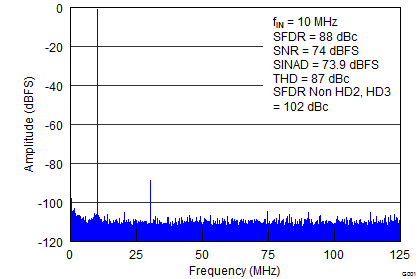
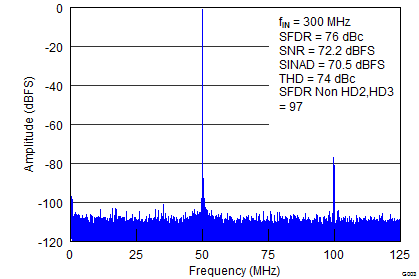
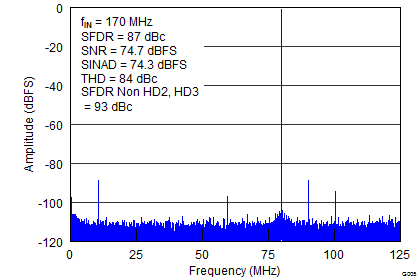
(2.5-VPP Full-Scale)
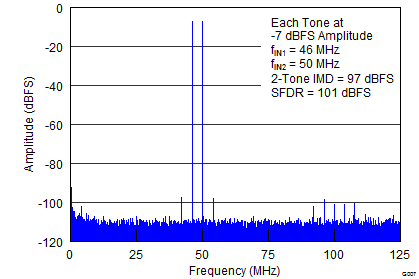
(At –7 dBFS, 46 MHz and 50 MHz)
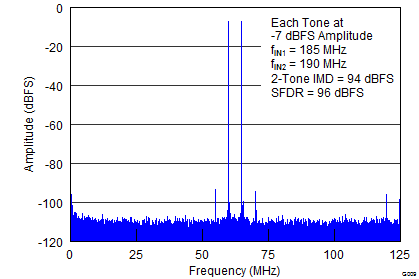
(At –7 dBFS, 185 MHz and 190 MHz)
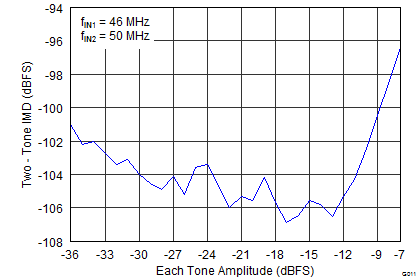
(46 MHz and 50 MHz)
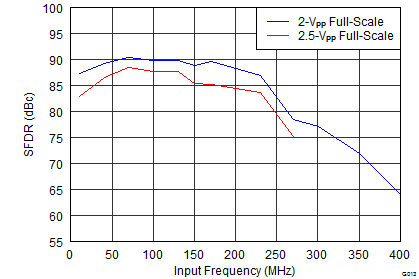
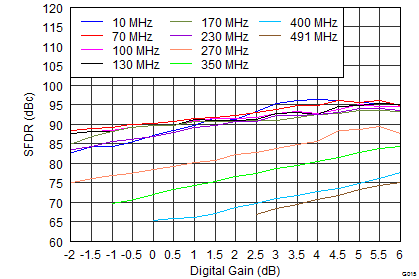
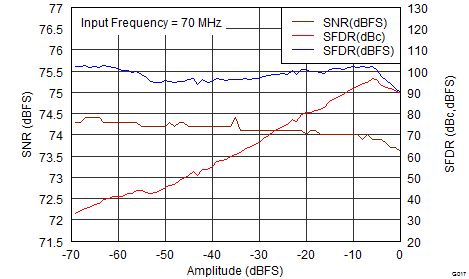
(70 MHz)
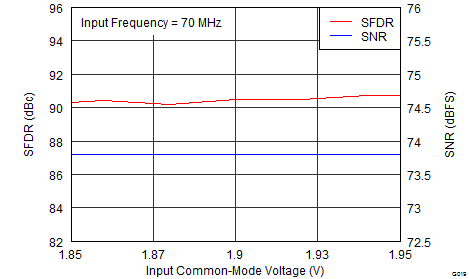
(70 MHz)
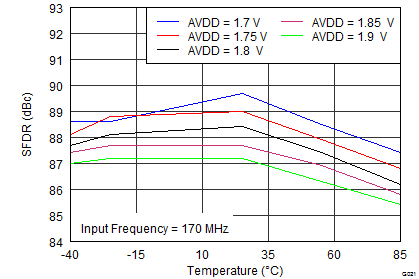
(170 MHz)
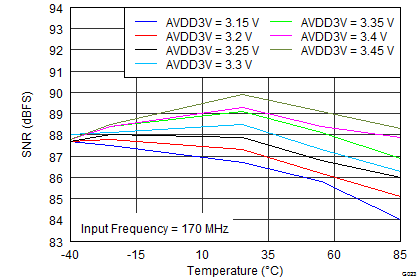
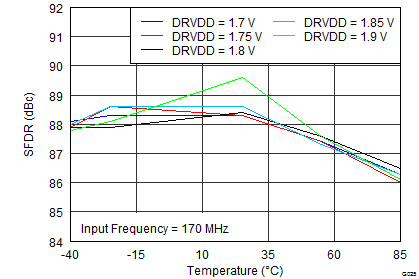
(170 MHz)
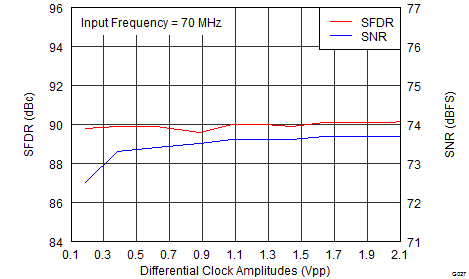
(70 MHz)
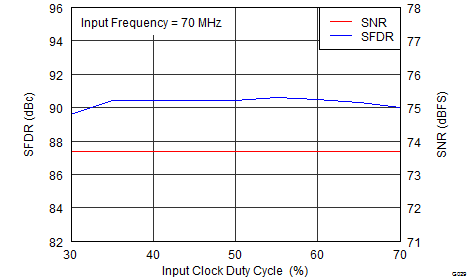
(70 MHz)
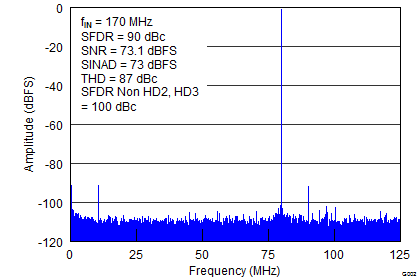
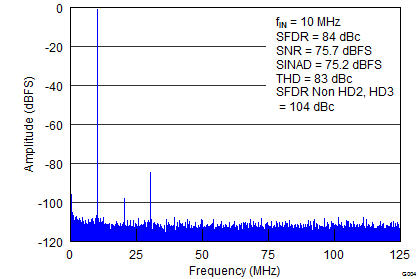
(2.5-VPP Full-Scale)
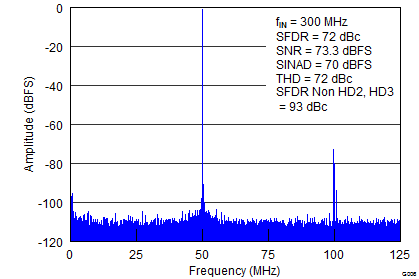
(2.5-VPP Full-Scale)
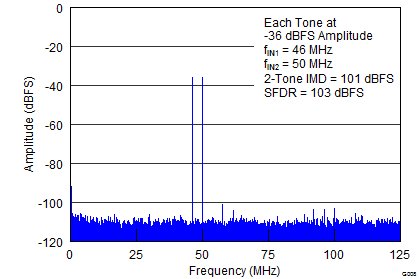
(At –36 dBFS, 46 MHz and 50 MHz)
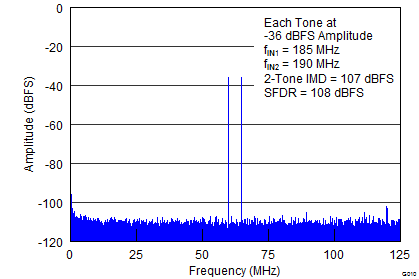
(At –36 dBFS, 185 MHz and 190 MHz)
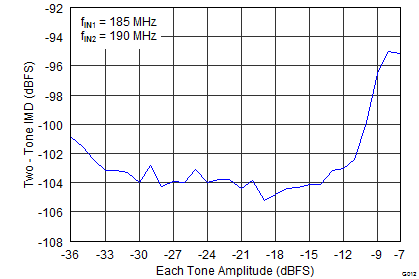
(185 MHz and 190 MHz)
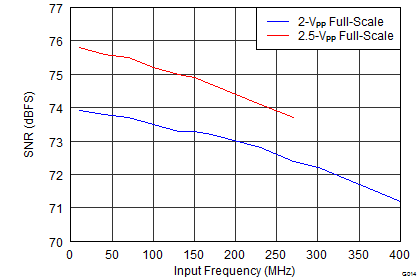
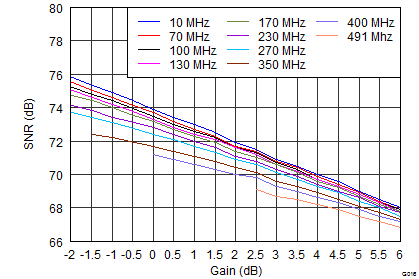
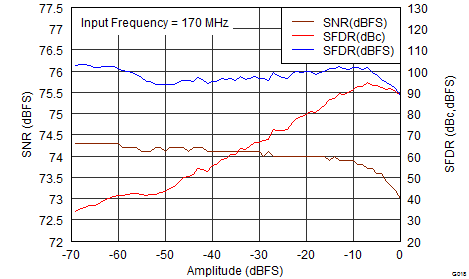
(170 MHz)
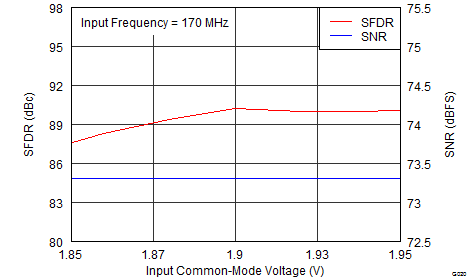
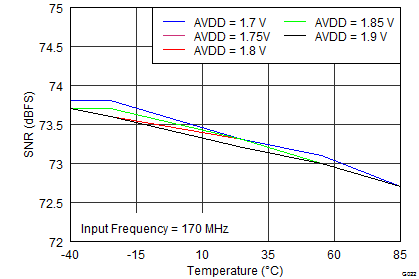
(170 MHz)
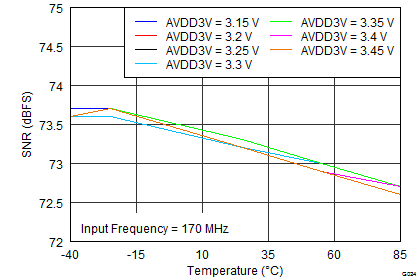
(170 MHz)
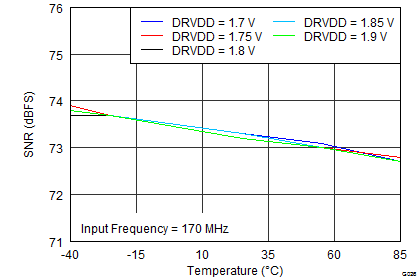
(170 MHz)
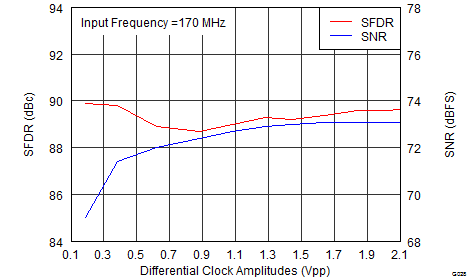
(170 MHz)
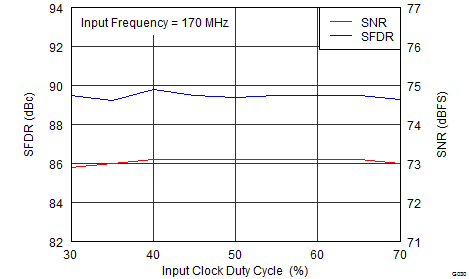
(170 MHz)
6.13 Typical Characteristics: ADS42LB49
Typical values are at TA = +25°C, full temperature range is TMIN = –40°C to TMAX = +85°C, ADC sampling rate = 250 MSPS, 50% clock duty cycle, AVDD3V = 3.3 V, AVDD = DRVDD = 1.8 V, –1-dBFS differential input, and 32k-point FFT, unless otherwise noted.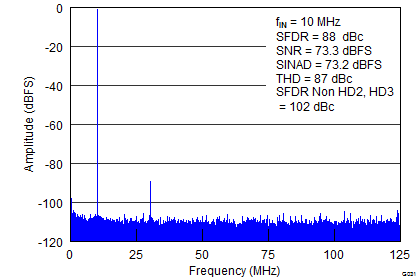
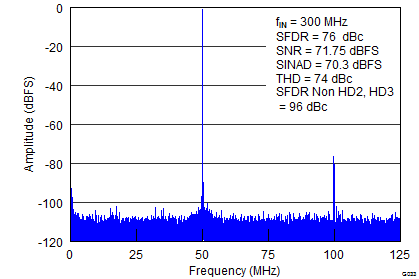
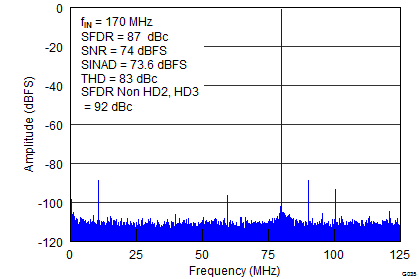
(2.5-VPP Full-Scale)
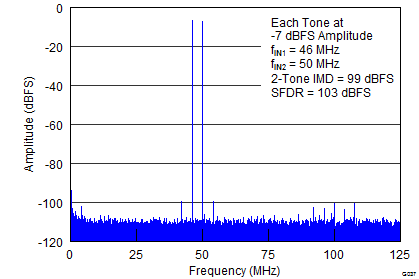
(At –7 dBFS, 46 MHz and 50 MHz)
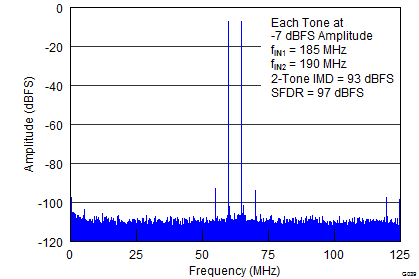
(At –7 dBFS, 185 MHz and 190 MHz)
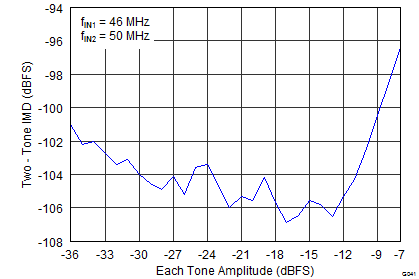
(46 MHz and 50 MHz)
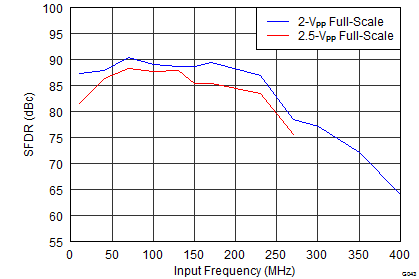
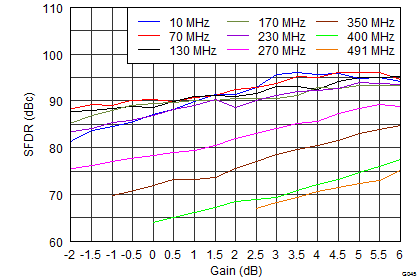
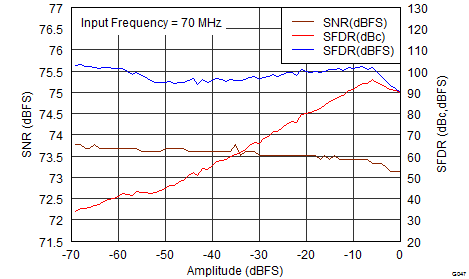
(70 MHz)
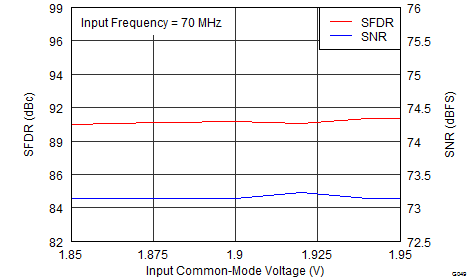
(70 MHz)
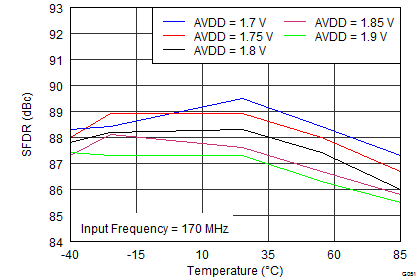
(170 MHz)
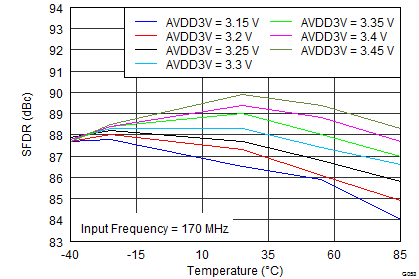
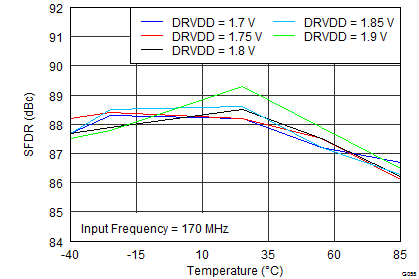
(170 MHz)
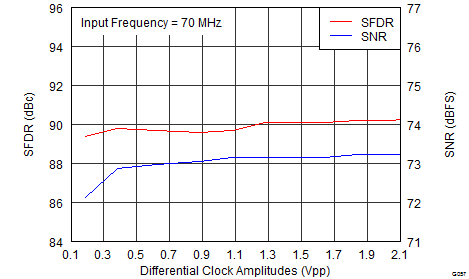
(70 MHz)
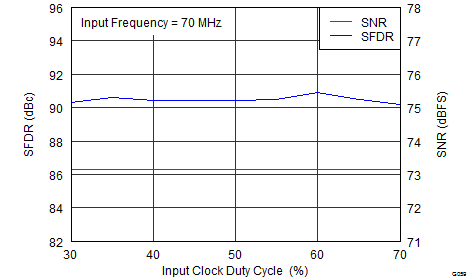
(70 MHz)
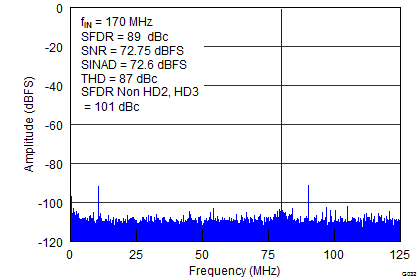
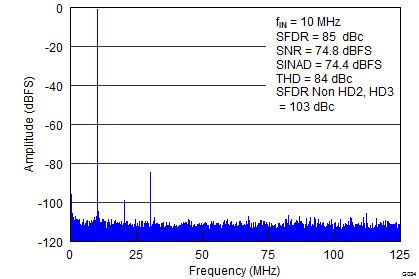
(2.5-VPP Full-Scale)
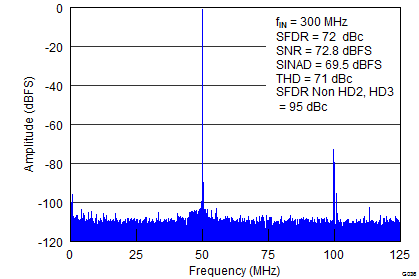
(2.5-VPP Full-Scale)
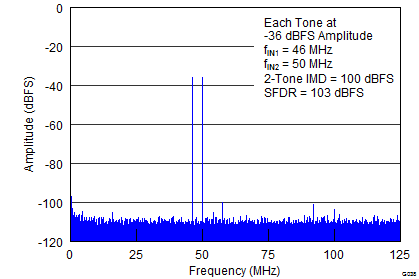
(At –36 dBFS, 46 MHz and 50 MHz)
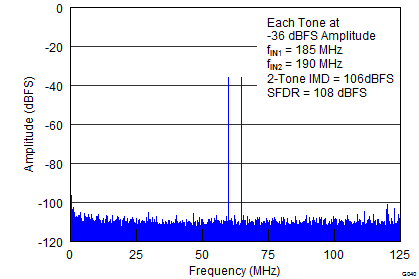
(At –36 dBFS, 185 MHz and 190 MHz)
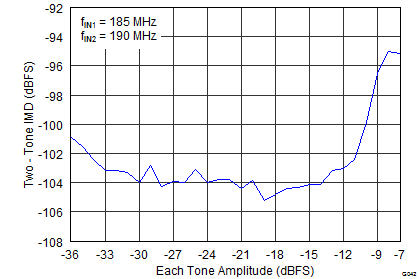
(185 MHz and 190 MHz)
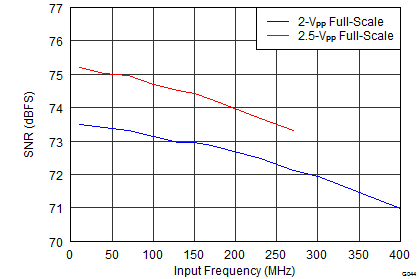
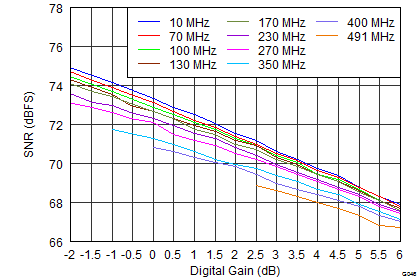
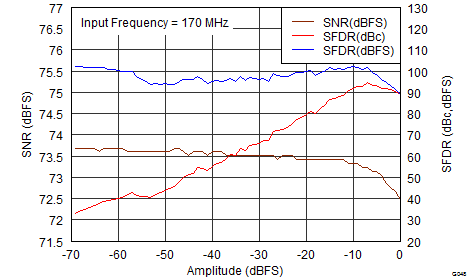
(170 MHz)
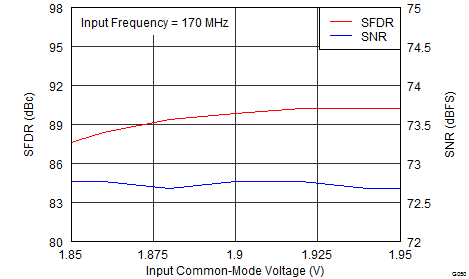
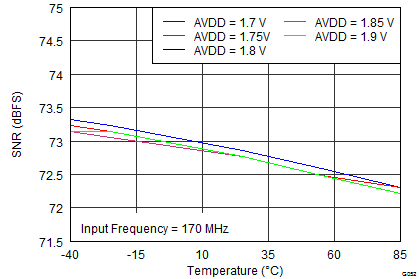
(170 MHz)
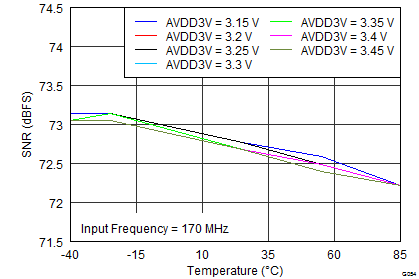
(170 MHz)
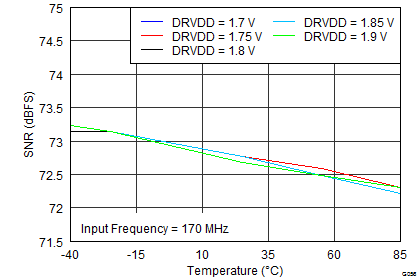
(170 MHz)
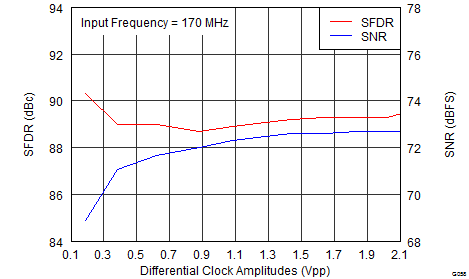
(170 MHz)
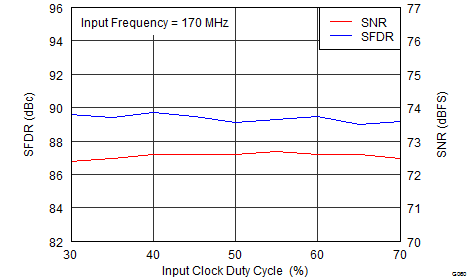
(170 MHz)
6.14 Typical Characteristics: Common
Typical values are at TA = +25°C, full temperature range is TMIN = –40°C to TMAX = +85°C, ADC sampling rate = 250 MSPS, 50% clock duty cycle, AVDD3V = 3.3 V, AVDD = DRVDD = 1.8 V, –1-dBFS differential input, and 32k-point FFT, unless otherwise noted.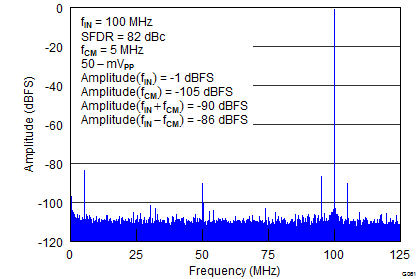
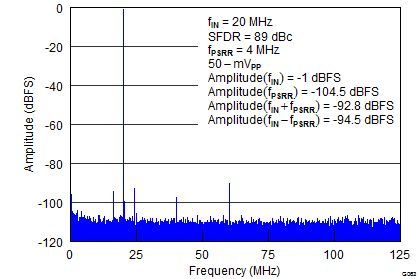
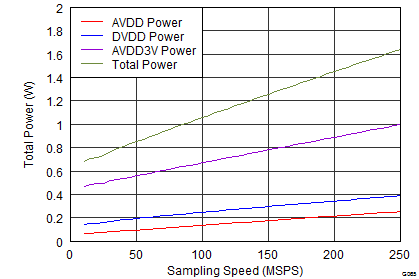
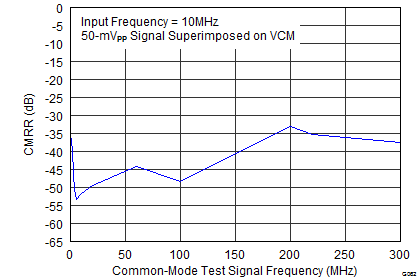
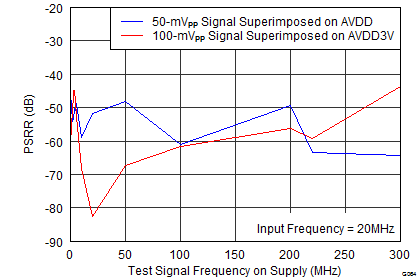
6.15 Typical Characteristics: Contour
Typical values are at TA = +25°C, full temperature range is TMIN = –40°C to TMAX = +85°C, ADC sampling rate = 250 MSPS, 50% clock duty cycle, AVDD3V = 3.3 V, AVDD = DRVDD = 1.8 V, –1-dBFS differential input, and 65k-point FFT, unless otherwise noted.6.15.1 Spurious-Free Dynamic Range (SFDR): General
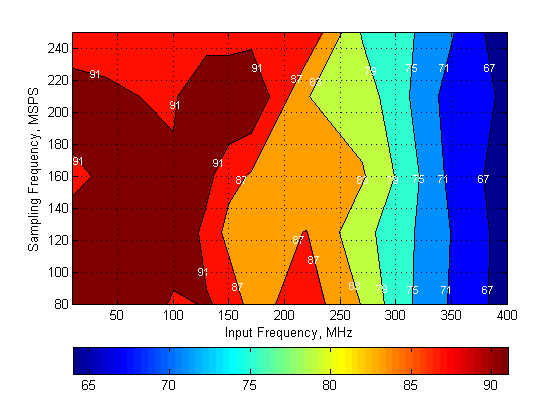
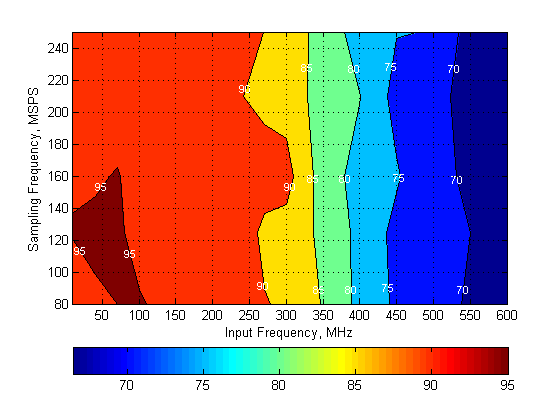
6.15.2 Signal-to-Noise Ratio (SNR): ADS42LB69
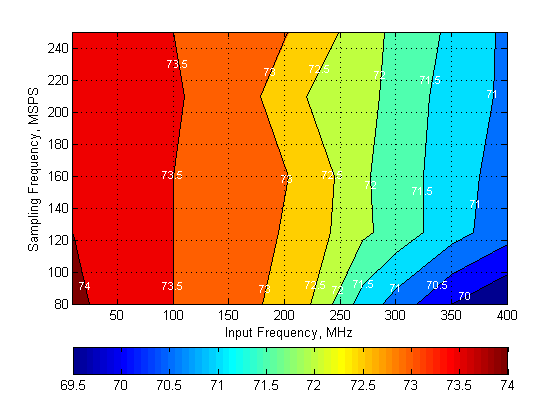
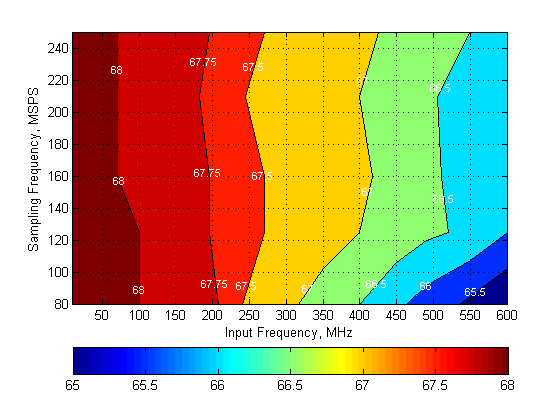
6.15.3 Signal-to-Noise Ratio (SNR): ADS42LB49
